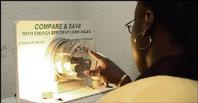Buy energy-efficient appliances
published:
Friday | December 16, 2005
Karlene Carby-Dixon, Contributor

Njeri Knight views an exhibit at the Petroleum Corporation of Jamaica Energy Efficiency Unit exhibition in the auditorium at their headquarters on Trafalgar Road, St. Andrew, in October. - RICARDO MAKYN/STAFF PHOTOGRAPHER
WHY NOT jump on board, and join the mission to conserve on energy? Don't get caught up with the need for fancy chandeliers in the home, and the view that energy-efficient equipment does not fit with the décor of your home.
While aesthetics is important, remember what you need even more is reduced light bills and savings to go towards other important things. Don't get discouraged either by the seemingly expensive energy-efficient appliances, because, believe it or not, there is a second price tag.
Energy-efficient appliances really cost less to own. Although energy-efficient models sometimes cost more when you make the initial purchase, the savings on your utility bill would outweigh this upfront cost. If you think about two price tags, you will find that it makes more sense to buy an energy-efficient appliance.
PRICE TAGS
The first price tag is the purchase price that you pay at the store when you buy the appliance, while the second is the cost to operate the appliance over its lifetime.
Take the case of the compact fluorescent lamps (CFLs) compared to its incandescent counterpart. While the incandescent bulb costs less upfront, it has a much shorter lifespan, and so the money you would spend constantly replacing these bulbs each time, you could simply invest in a CFL, which has 10 times the lifespan of the incandescent bulb. The CFL has a lifespan of 10,000 hours, compared to the incandescent bulb which has a lifespan of 1,000 hours. CFLs keep you cooler, because they provide the same intensity of light output, while giving off less heat.
CFLs are 75 per cent more efficient than incandescent bulbs. CFLs are also more environmentally friendly, as replacing three incandescent bulbs can eliminate 750 carbon dioxide emissions per year.
Karlene Carby-Dixon is an officer at the Petroleum Corporation of Jamaica.










